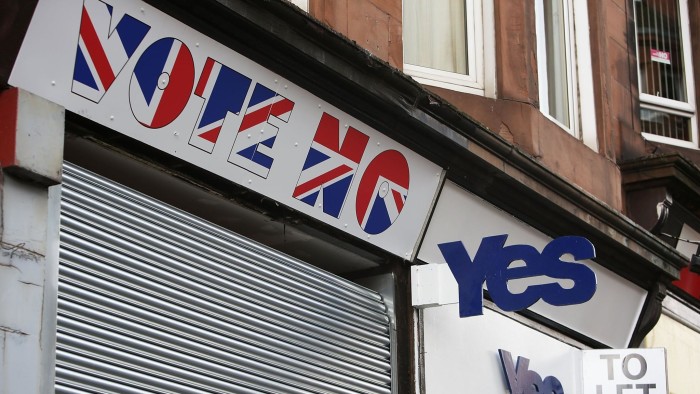Investors on high alert over Scottish independence referendum

Simply sign up to the Currencies myFT Digest -- delivered directly to your inbox.
If investors felt the first flutters of nerves last week over Scotland’s independence referendum, they are now on high alert.
The publication of the first poll to put the pro-independence campaign in the lead prompted a sharp fall in the pound on Monday and a sell-off in the shares of companies with Scottish exposure. It also led to a marked shift in investors’ expectations for the timing of the first rise in UK interest rates.
Until this month, markets had all but ignored the fierce political battle, viewing the risk of Scotland voting to break away from the UK as minimal. But recent polls showing a surge in support for the Yes campaign make the race a “statistical dead heat”, according to Michael Saunders, economist at Citigroup.
Now investors are scrambling to assess the economic, financial and political implications of a Yes vote and to protect themselves against the volatility it would unleash.
“We are in mild panic mode,” said James Ind, a fund manager at GLG.
Market pricing still implied a much smaller chance of a Yes vote than the odds bookmarkers were offering, he noted, but the “vertiginous” drop in sterling and an even clearer move in rates markets showed investors were on “high alert”.
London’s benchmark FTSE 100 index closed 0.3 per cent lower at 6834.77 on Monday, weighed down by financial institutions with a large exposure to Scotland. Shares in Standard Life fell 2.5 per cent, Lloyds Banking Group was down 2.4 per cent, while Royal Bank of Scotland slipped 1.29 per cent. Babcock International, which has large defence interests in Scotland, fell 2.35 per cent, while SSE, the Scottish utility operating on both sides of the border, shed 2.25 per cent.
The pound fell as much as 1.3 per cent against the dollar and euro on Monday, its biggest one-day drop in more than a year, and was down 1.1 per cent at $1.6150 at the end of the London trading day. Analysts expect a bigger fall – perhaps to about $1.50 – in the event of a Yes vote, and this is partly reflected in the bigger moves seen in currency options markets over the past week.
As well as buying protection against the uncertainties that would follow a Yes vote – ranging from the implications for the UK’s economic and fiscal position, to the currency Scotland would use, the future of its financial sector and its chances of joining the EU – investors are now betting it could delay a rise in UK borrowing costs.

Monday’s move in short sterling markets suggested they were now expecting the Bank of England to keep interest rates unchanged until April – compared with expectations a week ago that the first rate rise would come in March.
However, Mr Saunders cautioned it was simplistic to think a Yes vote would have a persistently dovish influence on monetary policy. It would be hard to imagine the BoE raising interest rates immediately after a Yes result but, in the longer term, it would be weighing any dip in business confidence against the inflationary impact of a weaker pound – so could even be more hawkish.
These longer-term considerations mean the implications of the referendum for gilt investors are harder to assess and the yield on UK benchmark 10-year gilts was little changed at 2.48 per cent on Monday.
Some foreign investors are becoming wary of holding UK debt. Torgeir Høien, a portfolio manager at the Norwegian fund Skagen Tellus, said he ditched UK gilts last week. But Alan Wilde, head of fixed income at Barings Asset Management, said trading the referendum risk was more straightforward in currency and rates markets.
In depth

Scotland will decide in a referendum to be held on September 18 2014 whether or not to end the 307-year-old union with England
Further reading
However, some analysts think the sell-off in currency markets has already been overdone. Given the backdrop of increasingly uncertain BoE policy and a more hawkish slant to recent statements by the US Federal Reserve, the pound is unlikely to regain its July peak even if Scottish risks dissipate – it has fallen about 6 per cent since then against a broadly strengthening dollar. But it would certainly bounce in the event of a No vote and could gain against the euro regardless of the referendum result, given the divergence of BoE policy with European Central Bank easing.
“A strong bounce in sterling is likely on a No vote, which is still very much the most likely outcome,” wrote Trevor Greetham, director of asset allocation at Fidelity Worldwide Investment. “In the event of a Yes, things would get messier, though we would still favour sterling over the euro. It is hard to argue the Bank of England would hold off tightening in 2015 due to what could be 18 months of divorce negotiations.”
Additional reporting by Andrew Bolger
Comments